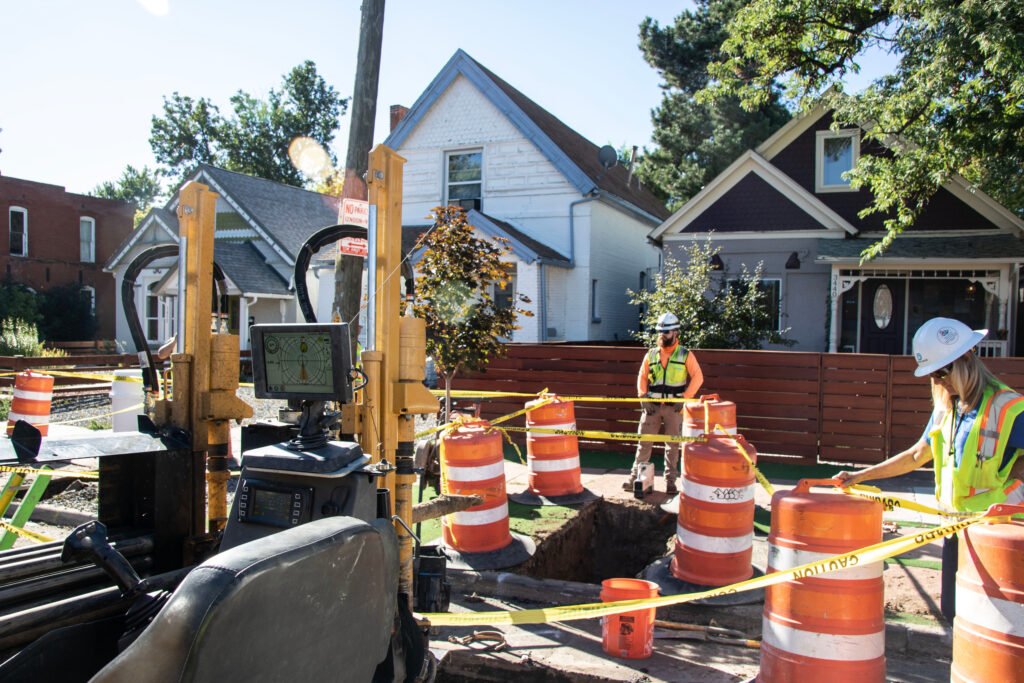On an early morning, a quiet Denver neighborhood was temporarily transformed into a construction zone. A boring machine on the road outside someone’s home pointed a long, thin drill bit at a sharp angle toward a hole in the ground. It’s going to make a path for a new water service line.
All the commotion is for a singular purpose: to reduce the amount of lead flowing into Denver homes.
“Previously, the technology was pulling (the old line) or open trench excavation, which is not customer friendly,” said Denver Water’s Alexis Woodrow. “People do not like their entire yard dug up.”
A man grabbed a big coil of copper line and brought it into the home. Another contractor took out an electronic locator to help guide the boring machine operator.
“They are essentially boring in a new line and then pulling out a copper (line) so they leave the lead abandoned in place,” said Woodrow, who manages the program. “That’s often because we can’t pull it out, or it’s just more efficient to put in a new line.”
This is just one of many work sites for the utility’s Lead Reduction Program—a nearly $670 million project designed to replace lead service lines with copper ones in the Denver area at no cost to the customer.
Lead is toxic. It can cause brain damage in children, as well as increase the risk of a miscarriage, according to the World Health Organization. Denver Water isn’t delivering lead-laden water to customers, Woodrow said, but old household plumbing and service lines can leech lead into that water and cause problems.
“There were homes in the Denver Water service area where lead levels were elevated and the corrosion treatment that we were doing was not sufficient enough to create that protection that they needed,” she said.
In 2012, Denver Water exceeded the lead action level of 15 parts per billion set by the Environmental Protection Agency, coming in at 17 parts per billion. Service lines are owned by the customer, but the utility felt the need to do something. The city researched effective treatment solutions and found that changing the pipe as well as increasing the pH of the water was their best bet.
Denver Water has found nearly 65,000 lead lines in the city, primarily in homes built before the 1950s. That’s roughly 220 miles of pipe, according to Denver Water officials. The condition of about 17,000 lines is still unknown.
Since starting the Lead Reduction Program in 2020, the utility has replaced around half of the lines. They also sent Brita pitchers and filter replacements to homes that are still waiting to get their lines replaced.
“What we were giving to them through this program was a chance at health and safety,” Woodrow said. “(We’re saying), ‘You are likely to have a lead service line, so here’s what Denver Water is going to do to protect you.’”
These replacements come in the wake of the Flint Water Crisis in Michigan in 2014, when the city changed their water source from Lake Huron to the Flint River. Pipes corroded and there were no treatment methods in place. Lead levels were nearly double the lead action level set by the EPA in most of the homes, while others were in the hundreds or thousands for parts per billion.
It put the dangers of lead in drinking water in the national spotlight. So why weren’t Denver’s lines, and others, replaced sooner?
Siddhartha Roy is a professor at Rutgers University and has done research on the Flint Water Crisis. He said one reason could be that lead was the plumbing standard in the turn of the 20th century when many cities were growing rapidly.
“Cities had mandates that, ‘Hey, if you want public water, you have to use a lead pipe,’” he said. “There was an industry push. There was a lead lobby, as hard as it is to believe that…it will poison you, but lead will last thousands of years.”
Woodrow with Denver Water said even as the dangers came to light, everything was still evolving and utilities were not sure what the best solution was at the time.
“I think there were a lot of questions within the industry, and also in public health, about how lead in drinking water kind of fits in the whole scale of lead exposure, and how serious it is,” she said.
It took until the late 1980s to ban lead pipes and until the late 1990s for lead regulations to take effect. But utilities didn’t want to replace or fix the expensive pipes, as one line could cost tens of thousands of dollars to replace. Washington D.C. had their own lead water crisis long before Flint. Utilities sometimes covered it up, according to Roy’s research. Roy said many cities used “cheats”, or extra testing steps to minimize the problem.
“You had steps like, ‘Oh, flush (the water) for a few minutes the night before you took a sample in the morning,’ and that lowers lead levels,” he said. “That made it appear that the problem was not as worse as we thought.”
This fall, the Biden Administration introduced a stricter policy, where cities have to remove all of their lead pipes by 2037. Cities will also have to comply with the new lead action level of 10 parts per billion.
Some local utilities have already gotten financial help from the EPA and the Biden administration to get started on this work. Denver Water received $76 million in funds from the Bipartisan Infrastructure Law to speed up this process. The utility was originally paying for its Lead Reduction program on its own with its water rates, bonds and hydropower sales.
Roy said he’s cautiously optimistic.
“The question is financing,” he said. “The question is organizing this at grand levels, coordinating. There’s so much to be done…This is the single biggest policy jump on improving lead in water in more than 30 years.”
When lines do get replaced, it can be revolutionary. Claire Thomas lives in a historic home built in 1890 in the Curtis Park Historic District near the Five Points area of Denver. She got a water filter from the utility and never expected any sort of replacement.
“It was just, this is our way of life,” she said. “We drink from the Brita, and just kind of accepted that.”
Thomas and her partner cook a lot and have friends over often. They’d end up using more water than their small filter could handle.
“In reality, we’ve probably been drinking water that has lead in it because we’ve been overusing our filters,” Thomas said.
When she first heard from the utility that her lines were going to be replaced, she was elated.
“I’ve been in a lead water house for so long, I was so excited,” she said. “That same day we returned to the post office with our water samples.”
She got her line replaced at the end of August. She was shocked at how quick the process was and how kind the workers were, cleaning up the street within a week and being very careful within her home.
“(I) feel really lucky moving into this house and a year later being able to have normal water,” she said. “And as I say that, I realize that that’s a weird thing to have to be thankful for, but here we are.”
Denver Water has about 1,000 more replacements to finish before the end of the year. It plans to work in East Denver in 2025 to stay on track with the goal of finishing the whole project within 15 years.
This story was produced by KUNC, in partnership with The Water Desk at the University of Colorado’s Center for Environmental Journalism.
About This Story
Perhaps you noticed: This story, like all the news we publish, is free to read. That’s because Inside Climate News is a 501c3 nonprofit organization. We do not charge a subscription fee, lock our news behind a paywall, or clutter our website with ads. We make our news on climate and the environment freely available to you and anyone who wants it.
That’s not all. We also share our news for free with scores of other media organizations around the country. Many of them can’t afford to do environmental journalism of their own. We’ve built bureaus from coast to coast to report local stories, collaborate with local newsrooms and co-publish articles so that this vital work is shared as widely as possible.
Two of us launched ICN in 2007. Six years later we earned a Pulitzer Prize for National Reporting, and now we run the oldest and largest dedicated climate newsroom in the nation. We tell the story in all its complexity. We hold polluters accountable. We expose environmental injustice. We debunk misinformation. We scrutinize solutions and inspire action.
Donations from readers like you fund every aspect of what we do. If you don’t already, will you support our ongoing work, our reporting on the biggest crisis facing our planet, and help us reach even more readers in more places?
Please take a moment to make a tax-deductible donation. Every one of them makes a difference.
Thank you,


